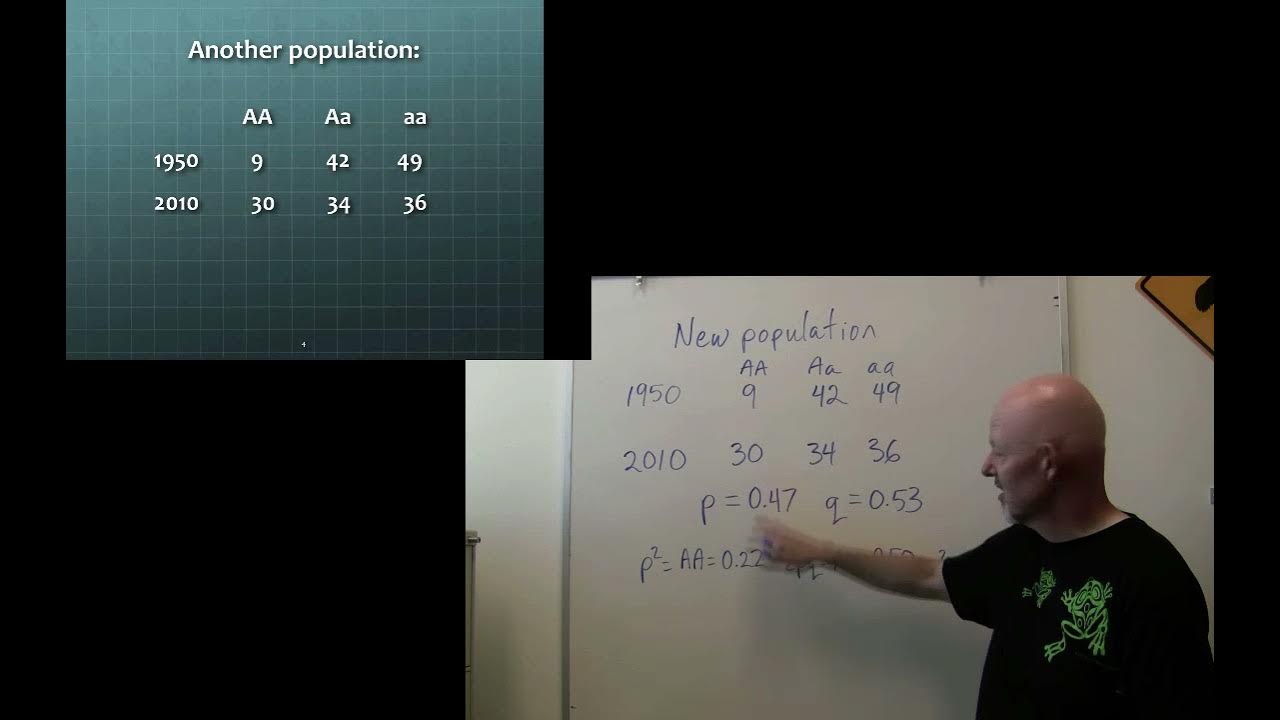Hardy-Weinberg Equilibrium
Summary
TLDRThis script delves into the intersection of biology and mathematics, specifically the Hardy-Weinberg Equilibrium, which posits that allele and genotype frequencies in a population remain constant unless influenced by evolutionary forces. It clarifies misconceptions about the prevalence of math in biology, outlines the five assumptions necessary for the equilibrium to hold, and provides a step-by-step guide to calculating allele and genotype frequencies using the Hardy-Weinberg equations. The script emphasizes the practical application of this theoretical framework in understanding evolutionary changes in populations.
Takeaways
- 🧩 Biology and math are intertwined, with various biological processes involving mathematical calculations.
- 🔍 The Hardy-Weinberg Equilibrium is a concept that combines biology and math, illustrating the balance of allele and genotype frequencies in a population.
- 🌐 Named after a mathematician and a physician, the Hardy-Weinberg Equilibrium states that allele and genotype frequencies remain constant in a population unless affected by evolutionary forces.
- 🐸 The concept is exemplified using a simplified model of frogs with different colors due to different genotypes (GG, Gg, gg).
- 📊 To be in Hardy-Weinberg equilibrium, five assumptions must be met: no selection, no mutation, no migration, a large population, and random mating.
- ⚠️ Hardy-Weinberg Equilibrium is often not observed in nature due to various evolutionary pressures, such as predators affecting the survival of certain phenotypes.
- 📐 The Hardy-Weinberg Equilibrium provides a mathematical baseline to compare evolving populations against stable ones without evolutionary influences.
- 📘 Two key equations represent the Hardy-Weinberg Equilibrium: p + q = 1 for allele frequencies, and p^2 + 2pq + q^2 = 1 for genotype frequencies.
- 🔢 The example given uses allele frequencies (p=0.6, q=0.4) to calculate genotype frequencies, demonstrating the application of the Hardy-Weinberg principles.
- 📝 When solving Hardy-Weinberg problems, it's crucial not to assume genotypes from phenotypes without clear evidence, as multiple genotypes can produce the same phenotype.
- 🔄 Practice is essential for mastering the calculations and applications of the Hardy-Weinberg Equilibrium, with many resources available for further learning.
Q & A
What is the common misconception about math in biology when people first start studying it?
-The common misconception is that there is no math in biology, but they soon find out that math is involved in various biological processes and calculations.
What is the Hardy-Weinberg Equilibrium and why is it significant in biology?
-The Hardy-Weinberg Equilibrium is a principle that states that a population's allele and genotype frequencies remain constant unless an evolutionary force acts upon them. It's significant because it provides a baseline to compare how an evolving population differs from one that remains constant without evolutionary forces.
What are the five assumptions required for a population to be in Hardy-Weinberg Equilibrium?
-The five assumptions are: 1) No selection, 2) No mutation, 3) No migration, 4) Large population, and 5) Random mating.
How do allele frequencies add up in a population according to the Hardy-Weinberg Equilibrium?
-Allele frequencies in a population must add up to 1, ensuring that the total contribution of all alleles is complete.
What does the equation p + q = 1 represent in the context of the Hardy-Weinberg Equilibrium?
-The equation p + q = 1 represents the sum of the frequencies of the dominant allele (p) and the recessive allele (q) in a population, which must equal 1.
What does the equation p^2 + 2pq + q^2 = 1 signify in the Hardy-Weinberg Equilibrium?
-This equation represents the genotype frequencies in a population, where p^2 is the frequency of homozygous dominant (GG), 2pq is the frequency of heterozygous (Gg), and q^2 is the frequency of homozygous recessive (gg).
Why is it incorrect to assume that the dominant allele frequency (p) must be larger than the recessive allele frequency (q) in a population?
-It's incorrect because the dominant allele isn't always more common in a population. The Hardy-Weinberg Equilibrium does not imply that p must be greater than q; it only requires that their sum equals 1.
How can you determine the allele frequencies from the genotype frequencies in a population?
-You can determine the allele frequencies by using the Hardy-Weinberg Equilibrium equations. For example, knowing the homozygous recessive frequency (q^2) allows you to calculate q by taking the square root, and subsequently, p can be found using p + q = 1.
What is the significance of practicing Hardy-Weinberg Equilibrium problems?
-Practicing helps in understanding the application of the Hardy-Weinberg Equilibrium in analyzing and comparing the extent of evolutionary forces acting on a population, providing a baseline for comparison.
Why is it important to check that the calculated values in the Hardy-Weinberg Equilibrium equations sum up to 1?
-Checking that the values sum up to 1 ensures the accuracy of the calculations and confirms that the allele and genotype frequencies are correctly represented according to the Hardy-Weinberg Equilibrium.
How can the Hardy-Weinberg Equilibrium be used to identify deviations from a stable genetic population?
-By comparing the calculated genotype and allele frequencies with the expected values under Hardy-Weinberg Equilibrium, one can identify deviations that may indicate the presence of evolutionary forces such as selection, mutation, migration, or genetic drift.
Outlines

このセクションは有料ユーザー限定です。 アクセスするには、アップグレードをお願いします。
今すぐアップグレードMindmap

このセクションは有料ユーザー限定です。 アクセスするには、アップグレードをお願いします。
今すぐアップグレードKeywords

このセクションは有料ユーザー限定です。 アクセスするには、アップグレードをお願いします。
今すぐアップグレードHighlights

このセクションは有料ユーザー限定です。 アクセスするには、アップグレードをお願いします。
今すぐアップグレードTranscripts

このセクションは有料ユーザー限定です。 アクセスするには、アップグレードをお願いします。
今すぐアップグレード5.0 / 5 (0 votes)






